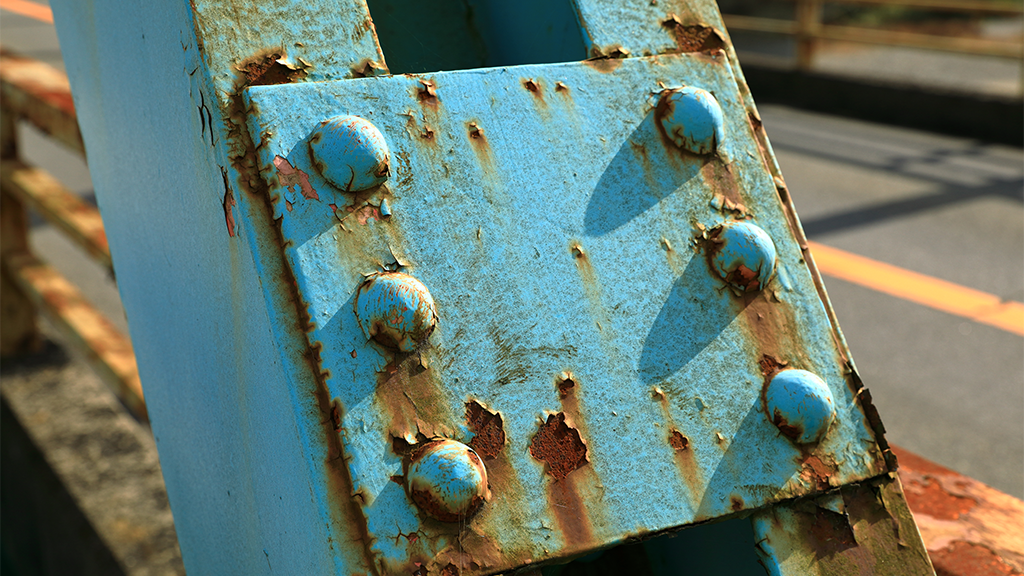Canada’s harsh climate and endless freeze-thaw cycles are especially hard on infrastructure like bridges.
Billions of dollars are spent each year rehabilitating and restoring steel crossings across the country.
A process known as galvanic corrosion is often the main reason for deteriorating bridge elements.
It occurs when two conductive metals are in contact with one another in the presence of an electrolyte like salt.
Canada’s total direct annual cost of corrosion is estimated to be $51.9 billion. Heavy use of de-icing salts on roads is believed to be the main cause of the problem.
A group of researchers recently looked into the matter and have come up with findings that can be used by engineers to make better decisions about materials and design practices in future bridges.
They studied 11 bridge alloys by using various electrochemical techniques, analysis and visual inspection of samples tested in a salt-water spray chamber.
The objective was to understand the magnitude of galvanic corrosion between commonly combined pairs of alloys that are used in bridges. Their report is being reviewed by several Canadian Standards Association (CSA) technical subcommittees that develop the Canadian Highway Bridge Design Code, known as CHBDC.
Importantly, the 64-page report determined using more corrosion-resistant metals in bridge construction, selecting bolts that would prevent anode action with bridge structural alloys, and reducing the salt content on bridges can be effective in lowering galvanic corrosion risk.
“Choosing a system for a bridge is currently based on empirical knowledge of material properties that do not directly integrate corrosion behaviour, exposure condition and relative contact area,” explains Mark Braiter, senior project manager, construction and infrastructure, at the CSA Group, who was on the project advisory panel.
“The goal is for the CHBDC to provide science-based guidance for protection and mitigation of the galvanic corrosion risk.”
Braiter notes there is increasing emphasis put on the sustainability and longevity of bridges and, because of this, better understanding of the interaction of aluminum decks and stainless-steel components with other metals and identification of potential mitigation measures is needed.
“Our hope is that the research will benefit bridge owners in providing safer and more durable infrastructure.”
The science of galvanic corrosion was not well understood before the report was published.
“Within the scope of metals studied, it quantifies what the community had a qualitative understanding about,” says Braiter. “The methodology could be applied to other arising issues related to new situations which combine high-performance steels, stainless steels and aluminum alloys in new ways.”
Jieying Zhang, a senior research officer at the National Research Council of Canada’s Construction Research Centre, and one of the authors of the report, says the findings are important because they conclude that galvanic corrosion is related to the metals selected, environmental exposure and configuration of bridges.
“The key findings of this study can be used by engineers and designers to make informed decisions on metal material selection and design practices to help prevent and mitigate galvanic corrosion in bridges.”
The report also provides an experimental method to measure the galvanic corrosion rate between two alloys and outlines a three-step procedure for engineers to interpret the risk of galvanic corrosion of metal alloys used in bridge structures.
“This approach begins with utilizing engineering experience and existing knowledge to assess the exposure conditions, materials and configuration for galvanic corrosion,” Zhang notes. “If the information gathered is insufficient, the second step involves using the galvanic series or conducting tests to evaluate the likelihood of galvanic corrosion between bridge alloys when used in combination.
“In more critical applications or harsh environments, it may be necessary to proceed to the final step, which involves quantitatively measuring the rate of galvanic corrosion through the experimental method.”
Researchers were surprised when they looked into using a stainless steel fastener alloy and found it was unsuitable for use in bridges in a salt-laden environment.
“This unexpected finding highlights the need to systematically develop knowledge of the corrosion behaviour of individual bridge alloys, beyond just their mechanical behaviour,” explains Zhang.
“By incorporating a deeper understanding of the environmental factors and corrosion of bridge alloys, it has the potential to improve the durability design of bridges with material selection and design practices to help prevent or mitigate the effects of corrosion.”
According to researchers, the report provides a new perspective on the evaluation of galvanic risk.
Interestingly, the report recommends a better understanding of aluminum bridges, as their high corrosion potential may not reflect their actual low corrosion rate due to protective aluminum oxides.
“The individual corrosion properties of bridge alloys, including their interactions with exposure conditions, need to be better understood, especially for weathering steel in chloride-laden environments,” says Zhang. “Further research is needed to develop risk assessment criteria for interpreting galvanic corrosion, and this study represents an initial effort to spur further discussion in the field.”



Recent Comments
comments for this post are closed